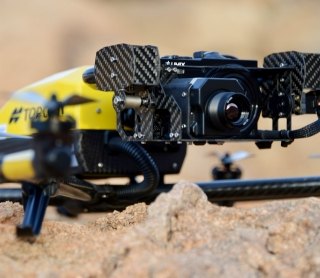The Environmental Business Journal (EBJ) recently interviewed SWCA’s Chief Technology Officer Linda Lannen for its Q3 2023 Technology & the Environmental Industry issue. The report is an analysis of technology deployment, investment, spending, service offerings, research and development, and long-term aspirations of companies and executives for the future of the environmental and climate change industries.
Lannen shared insight into how SWCA uses advanced imaging technology, artificial intelligence (AI), large language models like ChatGPT, and other technology to provide clients with high-quality data more quickly so that they can make better decisions that positively impact their business and the planet.
Read the Q&A below to learn more about how SWCA offers solutions to detect methane gas leaks at the specific fitting on a well, identify endangered species and cultural resources in the field with computer vision and audio models, sift through public comments databases, and more.
The below article is an excerpt from the Environmental Business Journal® Q3 2023: Technology & the Environmental Industry.
Download the full interview with SWCA CTO Linda Lannen here.
SWCA Uses Imaging Technology to Get Boots Off the Ground and Front-ends Projects with ChatGPT
Since 1981, SWCA has helped public and private clients overcome environmental challenges and move their projects forward. Our 100% employee-owned firm offers comprehensive sustainability advisory, environmental planning, regulatory compliance, and natural and cultural resources management services. We work together to understand the full life cycle of any project, from inception to completion. In the face of rapid environmental, economic, and societal changes, our purpose is simple: to preserve natural and cultural resources for tomorrow while enabling projects that benefit people today. We do that by offering a suite of environmental consulting services combined with local knowledge, regulatory expertise, and high-quality service. We build long-term, trusting relationships with our clients and guide their projects to successful completion. With a global presence, SWCA is able to rapidly pool resources and respond to our clients’ needs.
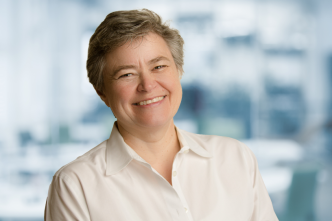 LINDA LANNEN, SWCA CHIEF TECHNOLOGY OFFICERLinda Lannen, Chief Technology Officer. Ms. Lannen has more than 20 years of experience in the AEC industry, tackling the most daunting of technology projects, including ERP system replacements, wide area network migrations, data center to cloud migrations, and implementations of enterprise security programs. She has previously worked for a variety of firms, ranging from dot-coms to Fortune 500 companies, and across industries including environmental engineering, telecommunications research, and food manufacturing.
LINDA LANNEN, SWCA CHIEF TECHNOLOGY OFFICERLinda Lannen, Chief Technology Officer. Ms. Lannen has more than 20 years of experience in the AEC industry, tackling the most daunting of technology projects, including ERP system replacements, wide area network migrations, data center to cloud migrations, and implementations of enterprise security programs. She has previously worked for a variety of firms, ranging from dot-coms to Fortune 500 companies, and across industries including environmental engineering, telecommunications research, and food manufacturing.
EBJ: In which ways is advanced imagery adding value to our industry? Which new technologies are coming out and how do you think that those technologies will evolve over the next 5 years?
Linda Lannen: We have developed unique capabilities to leverage imaging from a variety of sources – satellites, fixed wing and rotor wing aircraft, drones, and people on the ground. Satellite data is great for monitoring site changes over time, whether it’s construction, vegetation, or damage from natural disasters. We currently employ a variety of sensors, as well, from LiDAR to multi-spectral and infrared, to meet our clients’ needs on diverse projects. One of the most exciting new services we offer is methane gas leak detection from our UAVs. The ability to pinpoint which fitting on a well is leaking provides actionable information to our clients. Other services we’ve seen can show which field has a leaking well, but they can’t identify the specific fitting. The level of specificity we provide saves the client money, and it’s good for the environment because we can address issues promptly.
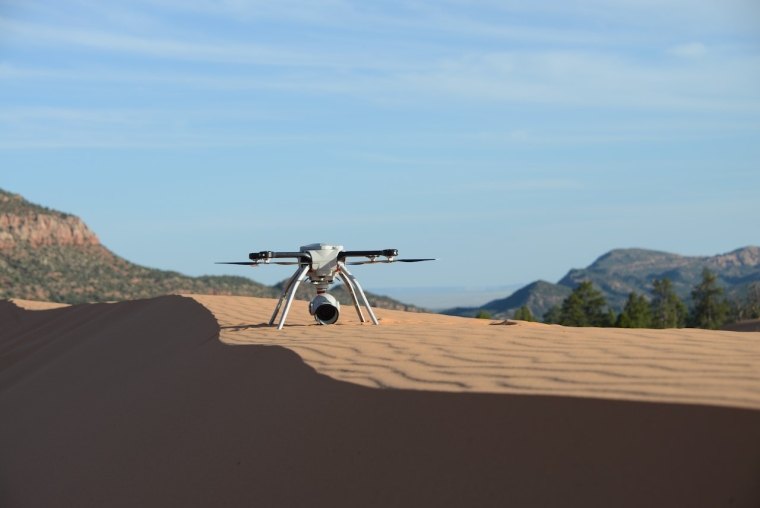 SWCA ACTIVELY CAPTURES AND FUSES RELEVANT PROJECT DATA IN NEAR REAL TIME EMPLOYING A MYRIAD OF SENSORS (PAYLOADS/CAMERAS) USING ROBOTS OPERATING FROM LAND, SEA, AIR, AND SPACE.We are shifting from the literal boots-on-the-ground model for some of our fieldwork – which is the most expensive for our clients – to offering incredibly high-resolution and near-real-time satellite data that’s approaching 30cm/pixel. Our clients constantly remark on the high quality of the imaging we can provide without having people on the ground. Having this actionable information on a timelier basis enables our clients to make better decisions that positively impact their business and our planet.
SWCA ACTIVELY CAPTURES AND FUSES RELEVANT PROJECT DATA IN NEAR REAL TIME EMPLOYING A MYRIAD OF SENSORS (PAYLOADS/CAMERAS) USING ROBOTS OPERATING FROM LAND, SEA, AIR, AND SPACE.We are shifting from the literal boots-on-the-ground model for some of our fieldwork – which is the most expensive for our clients – to offering incredibly high-resolution and near-real-time satellite data that’s approaching 30cm/pixel. Our clients constantly remark on the high quality of the imaging we can provide without having people on the ground. Having this actionable information on a timelier basis enables our clients to make better decisions that positively impact their business and our planet.
EBJ: Tell us about Artificial Intelligence. How is the industry leveraging emerging capabilities to lower costs and increase insight?
Lannen: “Artificial intelligence” includes a wide set of tools – some have been in use for decades, but the ChatGPT craze has brought others out of the shadows. Five years is a lifetime in the technology world – but I do think that machine learning will be more fully integrated into our workflows. I look at tools like ChatGPT as having a research assistant who can start that presentation or report. It saves time on tasks we’d rather not do ourselves, and it can identify trends that we might miss. The experts can then assess what these tools produce, fact-check, fine-tune, and
deliver a faster and higher quality service.
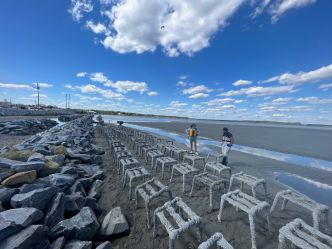 ARTIFICIAL OYSTER REEFS ON AN SWCA LIVING SHORELINE PROJECT IN NC.Over the past few years, we developed several computer vision and audio models to identify field items and species, which have been very useful with endangered species, invasive species, and cultural artifacts. Those are useful in a somewhat limited manner. Real insight provided with AI will be in complex mathematical models and in identifying trends – think of greenhouse gas emissions and similar scientific insights – as well as in mapping the impact of coastal erosion and sea-level change. For example, one of our scientists has developed a model predicting where oyster beds are likely to be along a coastline. The results help paint a large picture of where oysters are probably located. That information can then assist scientists on the ground who are inspecting and ground-truthing those locations. When you combine these AI tools with maps, the issues come to life for people as they relate to geospatial data more than charts and spreadsheets.
ARTIFICIAL OYSTER REEFS ON AN SWCA LIVING SHORELINE PROJECT IN NC.Over the past few years, we developed several computer vision and audio models to identify field items and species, which have been very useful with endangered species, invasive species, and cultural artifacts. Those are useful in a somewhat limited manner. Real insight provided with AI will be in complex mathematical models and in identifying trends – think of greenhouse gas emissions and similar scientific insights – as well as in mapping the impact of coastal erosion and sea-level change. For example, one of our scientists has developed a model predicting where oyster beds are likely to be along a coastline. The results help paint a large picture of where oysters are probably located. That information can then assist scientists on the ground who are inspecting and ground-truthing those locations. When you combine these AI tools with maps, the issues come to life for people as they relate to geospatial data more than charts and spreadsheets.
The industry absolutely needs to shift to leveraging more technology – whether simple automation or more complex AI large language models (LLMs) to automate mundane, repetitive tasks. This frees our experts to focus on the truly innovative, creative thinking that goes into protecting and restoring the environment.
EBJ: Is ChatGPT just the latest technology flavor of the month? Or is it and other Natural Language Processing platforms generating real usable outputs suitable for work products? And please provide some examples of where AI is contributing real short-term value, and to what types of project work?
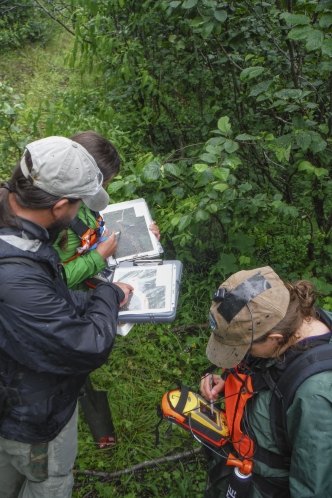 RELIABLE DATA COLLECTION IN THE FIELD WORKS BEST WITH ADVANCED ANALYSIS IN THE OFFICE.Lannen: ChatGPT and other LLM tools are demonstrating the value of Artificial Intelligence in a more “consumerized” version. Previously you needed to understand data science, some R programming language, and a bit of advanced statistics to be able to leverage AI tools. I see these LLMs as some of the first tools that anyone can use for a wide variety of tasks. SWCA is leveraging these and other AI tools for a wide variety projects, from species identification to assisting with report writing. We have an AI task force that is a fantastic combination of data scientists, project leaders and field scientists who are collaborating and prioritizing the many requests our Technology team receives for using tools on projects and in corporate services. We are using it to sift through public comments databases, and for a number of geographical delineation projects. The speed with which you can process data and identify trends is remarkable – and the secret sauce in using AI is to pair it with our scientific expertise. Using it alone gets you a certain distance, but you need to have expertise to train the models.
RELIABLE DATA COLLECTION IN THE FIELD WORKS BEST WITH ADVANCED ANALYSIS IN THE OFFICE.Lannen: ChatGPT and other LLM tools are demonstrating the value of Artificial Intelligence in a more “consumerized” version. Previously you needed to understand data science, some R programming language, and a bit of advanced statistics to be able to leverage AI tools. I see these LLMs as some of the first tools that anyone can use for a wide variety of tasks. SWCA is leveraging these and other AI tools for a wide variety projects, from species identification to assisting with report writing. We have an AI task force that is a fantastic combination of data scientists, project leaders and field scientists who are collaborating and prioritizing the many requests our Technology team receives for using tools on projects and in corporate services. We are using it to sift through public comments databases, and for a number of geographical delineation projects. The speed with which you can process data and identify trends is remarkable – and the secret sauce in using AI is to pair it with our scientific expertise. Using it alone gets you a certain distance, but you need to have expertise to train the models.
EBJ: How have your IT budgets changed over the past couple of years and what do you expect in the near future? And how do you see those budgets being allocated?
Lannen: Most firms’ technology budgets have shifted a lot of capital expense to operating expense as we have adopted more cloud and SAAS technologies. It’s not necessarily cheaper, but it’s a change. I also see IT evolving from a pure cost center to becoming a hybrid P&L as we work with our consulting colleagues to deliver data-driven solutions to our clients.
EBJ: How did you get involved in the Environmental industry in the first place and what were some of your early Inspirations or mentors or leaders that inspired you further?
Lannen: I first got involved in the Environmental industry when I went to work for a technology startup/subsidiary of MWH Global in 2002. They were later absorbed into MWH. This is where I met the late Dr. Vic Gulas, who was a tremendous mentor and sponsor for me. He was the Chief People and Knowledge Officer (best title ever!) at MWH Global. His work included that intersection of people, knowledge, and technology – and we did some notable work on social networks (how work gets done and how you develop trust among teams) that influences and inspires me today. Another great mentor and friend for me is Kathryn Simon, who taught me that you can be a manager, leader, and a friend, and how to juggle those hats with your team.
EBJ: What evidence of climate change or environmental degradation have you experienced personally in your lifetime?
Lannen: One impact of climate change that I’ve experienced – I moved to Southern California 12 years ago, and am blessed to have two homes in a coastal region and in the mountains. When I first moved here, most people didn’t have air conditioning in either place. Now, people are installing A/C in droves in both areas as the temperatures rise for longer periods during the summer. Clearly this is a firstworld “problem,” but it is remarkable to me that it’s happened in both places and only over a decade or so.
